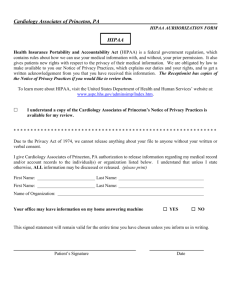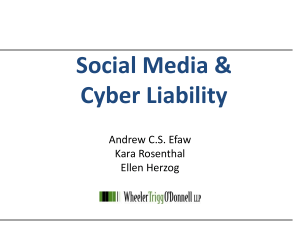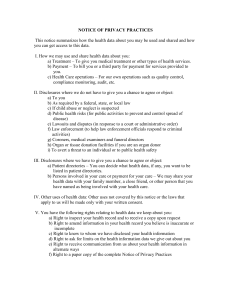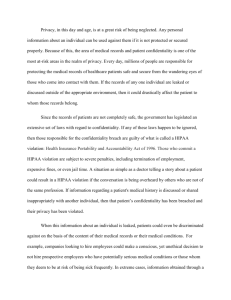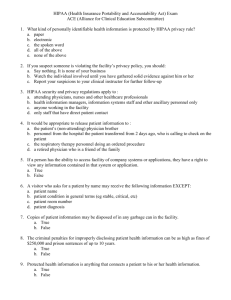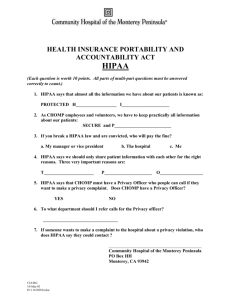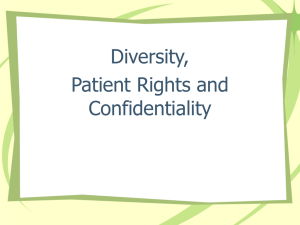Drug Seeking Behavior Whitepaper
advertisement
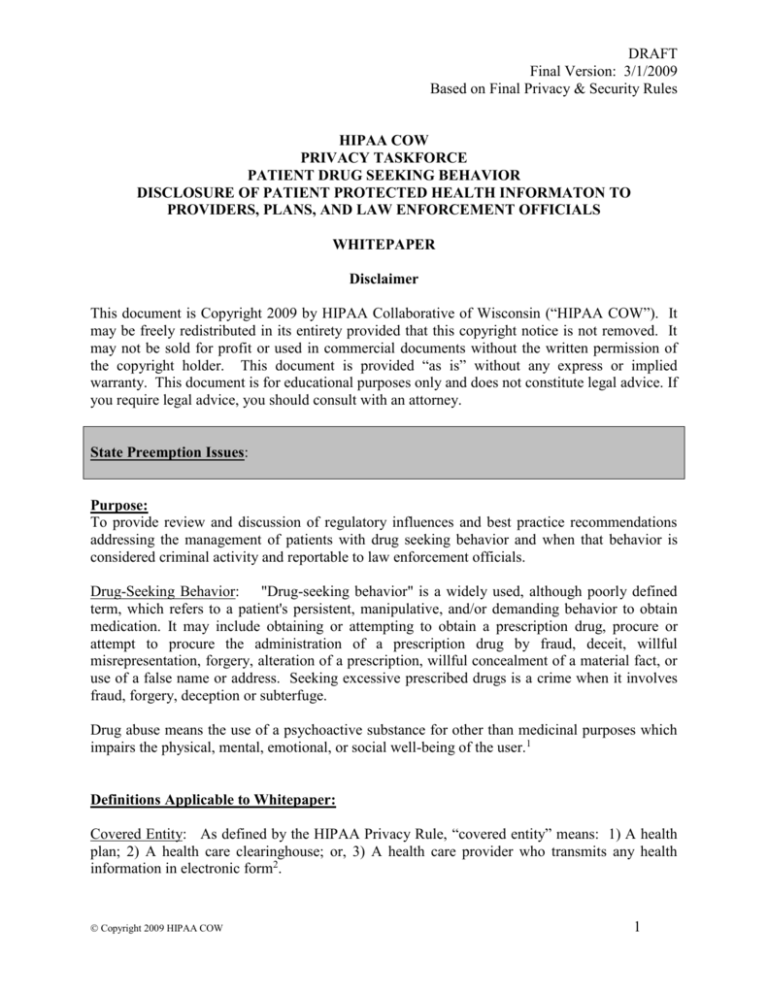
DRAFT Final Version: 3/1/2009 Based on Final Privacy & Security Rules HIPAA COW PRIVACY TASKFORCE PATIENT DRUG SEEKING BEHAVIOR DISCLOSURE OF PATIENT PROTECTED HEALTH INFORMATON TO PROVIDERS, PLANS, AND LAW ENFORCEMENT OFFICIALS WHITEPAPER Disclaimer This document is Copyright 2009 by HIPAA Collaborative of Wisconsin (“HIPAA COW”). It may be freely redistributed in its entirety provided that this copyright notice is not removed. It may not be sold for profit or used in commercial documents without the written permission of the copyright holder. This document is provided “as is” without any express or implied warranty. This document is for educational purposes only and does not constitute legal advice. If you require legal advice, you should consult with an attorney. State Preemption Issues: Purpose: To provide review and discussion of regulatory influences and best practice recommendations addressing the management of patients with drug seeking behavior and when that behavior is considered criminal activity and reportable to law enforcement officials. Drug-Seeking Behavior: "Drug-seeking behavior" is a widely used, although poorly defined term, which refers to a patient's persistent, manipulative, and/or demanding behavior to obtain medication. It may include obtaining or attempting to obtain a prescription drug, procure or attempt to procure the administration of a prescription drug by fraud, deceit, willful misrepresentation, forgery, alteration of a prescription, willful concealment of a material fact, or use of a false name or address. Seeking excessive prescribed drugs is a crime when it involves fraud, forgery, deception or subterfuge. Drug abuse means the use of a psychoactive substance for other than medicinal purposes which impairs the physical, mental, emotional, or social well-being of the user.1 Definitions Applicable to Whitepaper: Covered Entity: As defined by the HIPAA Privacy Rule, “covered entity” means: 1) A health plan; 2) A health care clearinghouse; or, 3) A health care provider who transmits any health information in electronic form2. Copyright 2009 HIPAA COW 1 DRAFT Final Version: 3/1/2009 Based on Final Privacy & Security Rules Health Care: Care, services, or supplies related to the health of an individual. Health care includes, but is not limited to, the following: 1) Preventive, diagnostic, therapeutic, rehabilitative, maintenance, or palliative care, and counseling, service, assessment, or procedure with respect to the physical or mental condition, or functional status, of an individual or that affects the structure or function of the body; and 2) Sale or dispensing of a drug, device, equipment, or other item in accordance with a prescription.3 Health Information: Health information means any information, whether oral or recorded in any form or medium, that: 1) Is created or received by a health care provider, health plan, public health authority, employer, life insurer, school or university, or health care clearinghouse; and 2) Relates to the past, present, or future physical or mental health or condition of an individual; the provision of health care to an individual; or the past, present, or future payment for the provision of health care to an individual.4 Health Plan: An individual or group plan that provides, or pays the cost of, medical care.5 A health plan is often referred to as the “payer.” Healthcare Provider: Health care provider means a provider of medical or health services and any other person or organization who furnishes, bills, or is paid for health care in the normal course of business.6,7 Individually Identifiable Information: Information that is a subset of health information, including demographic information collected from an individual, and is 1) created or received by a health care provider, health plan, employer, or health care clearinghouse; and 2) Relates to the past, present, or future physical or mental health or condition of an individual; the provision of health care to an individual; or the past, present, or future payment for the provision of health care to an individual; and identifies the individual or with respect to which there is a reasonable basis to believe the information can be used to identify the individual.8 Law Enforcement Official: An officer or employee of any agency or authority of the United States, a State, a territory, a political subdivision of a State or territory, or an Indian tribe, who is empowered by law to: 1) Investigate or conduct an official inquiry into a potential violation of law; or 2) Prosecute or otherwise conduct a criminal, civil, or administrative proceeding arising from an alleged violation of law.9 Patient Health Record: Records related to the health of a patient prepared by or under the supervision of a health care provider.10 Protected Health Information: Protected health information means individually identifiable health information transmitted or maintained in any other form or medium.11 Key Federal and State Laws Impacting Provider Health Records Management: 1. Wisconsin §§ 146.81-84: These statutes cover patient health records of a general medical nature, establishing the confidentiality of the records as well as additional Copyright 2009 HIPAA COW 2 DRAFT Final Version: 3/1/2009 Based on Final Privacy & Security Rules provisions addressing disclosure, patient right of access, record content, preservation of records, etc. 2. Wisconsin § 51.30: This section of the Mental Health Act covers registration and treatment records for those patients receiving services for mental illness, developmental disabilities, alcoholism, or other drug dependence. This statute is further supported by Federal Law 42 CFR Part 2. 3. Health Insurance Portability & Accountability Act (HIPAA) – 45 CFR §§ 160, 164: HIPAA Privacy and Security Rules require covered entities (e.g., healthcare providers which transmits PHI in an electronic format, health plans, and healthcare clearinghouses) to implement standards to safeguard the privacy and security of patient protected health information (PHI). These standards impact every facet of use and disclosure of patient PHI/records by covered entities. 4. Confidentiality of Alcohol and Drug Abuse Patient Records – 42 CFR Part 2: Establishes the confidentiality of alcohol and drug abuse (AODA) patient records in federally funded AODA prevention and treatment programs including how patient records/information can be disclosed. Attachments to Whitepaper: Attachment A: Summary of Applicable Wisconsin Statutes Covering Drug Seeking Behavior Attachment B: Federal and State Regulations Regarding Reporting of Criminal Drug Seeking Behavior to Law Enforcement Officials General Statements/Guidance: 1. The most common prescription drugs sought and abused are:12 A. OxyContin (Oxycodone). B. Valium (Diazepam). C. Vicodin (Acetaminophen/Hydrocodone). D. Percocet (Acetaminophen/Oxycodone). E. Xanax (Alprazolam). F. Dolophine (Methadone). G. Suboxone (Buprenorphine). 2. A provider may request verification of patient identity by a picture ID or other identifying information at any time. If there is suspicion that a patient is falsely presenting for pain control or another condition requiring pain management, it is recommended that verification of patient identity be established. 3. If during the course of the patient care encounter, the provider suspects that the patient is exhibiting Drug Seeking Behavior, the reason shall be documented objectively in the Copyright 2009 HIPAA COW 3 DRAFT Final Version: 3/1/2009 Based on Final Privacy & Security Rules patient’s health record. When applicable, the following information should be included in the documentation: A. Provision of appropriate medical screening examination and stabilizing treatment if the patient has presented to the emergency department or to another area of the hospital appearing to need emergency care (Emergency Medical Treatment and Active Labor Act - EMTALA). B. Results of positive blood or urine drug screen tests. C. Review of past history of drug-seeking behavior (based on review of objective findings in the patient’s health record history/documentation, etc.). D. Summary of feedback from other reliable and objective internal and external resources as determined appropriate by the provider (e.g., other health care providers, nursing staff, pharmacists, etc.). E. Objective and subjective findings upon patient presentation (e.g., What is the patient saying? Doing? How is the patient acting?). F. Referral to the patient’s primary healthcare provider or a pain management specialist, if appropriate. G. Referral to available internal resources such as social services, counselor, other healthcare provider, if appropriate. H. Recommended use of alternative modes of acute pain management such as local nerve blocks, physical therapy, etc. I. Referral for counseling, if drug abuse or misuse is suspected. J. Establishment of a pain management contract. K. Clear communication with the patient about the fact that they are exhibiting Drug Seeking Behavior, their treatment plan, the amount of narcotic medication that is necessary in the provider's opinion if any, the fact that the amount or type they are seeking is not necessary or advisable, and education about the fact that refusal to prescribe narcotics is not a refusal of care. L. Provision of only a limited supply of medication if a prescription is issued. M. Counseling of the patient about the appropriate use of controlled substances, including the risks and warnings of the symptoms of dependence. 4. A final diagnosis of “Drug Seeking Behavior” should not be documented and/or assigned an ICD-9-CM code (unless there are strong objective findings recorded in the health record to support the diagnosis).13 5. The healthcare provider/organization may consider placing an “alert” on the patient’s health record to heighten awareness of the Drug Seeking Behavior and communicate such to other healthcare providers within the organization/system. The decision to place an “alert” on the patient’s health record shall be made by the patient’s provider. Access to “alert” notifications shall be only on a “need-to-know” basis for those workforce members who require access to patient health information.14 Technical support for limited access to alert information may be dependent on application configuration. If the organization is unable to limit access to minimum necessary, non-identifying wording should be considered (e.g., “Medication Alert”). Copyright 2009 HIPAA COW 4 DRAFT Final Version: 3/1/2009 Based on Final Privacy & Security Rules 6. Healthcare organizations shall provide education to workforce members on this policy as well as any other resources for providers who may encounter patients demonstrating drug seeking behavior, particularly in the emergency departments and clinics. The information provided in this policy is established as guidance and is not intended to restrict or limit the provider’s right to exercise his or her independent professional judgment. Sharing Patient Drug Seeking Behavior Information with Other Healthcare Providers Guidance: 1. In general, a healthcare provider may exchange treatment and payment information with other healthcare providers when there is a direct patient-provider treatment relationship. It is not necessary to obtain patient authorization for this purpose in a general medical setting. However, there are limitations in disclosing patient protected health information from treatment records from mental health and AODA treatment facilities.15 Some examples of exchange of information for treatment purposes in a general medical setting may include: A. Queries to other providers involved in the patient’s care regarding the patient’s medical/medication history. B. Provision of health information/records to providers to which the patient has been referred (pending appointment). C. Exchange of patient medication/prescription information with the pharmacy which has or will dispense medication, including validation of prescription information. 2. The decision as to whether a healthcare provider should notify external healthcare providers and/or emergency departments of a patient who may be “making the rounds” with Drug Seeking Behavior needs to be determined by the organization based on the risks and benefits for doing so. There is no clear direction from federal or state laws that address this practice and how it fits into a past, present, or future patient-provider relationship. Sharing of Patient Drug Seeking Behavior/Information Between Health Providers and Health Plans: Federal and state laws allow health care providers to share information with health plans for treatment (including case management), payment, or health care operations (e.g. quality improvement) purposes. Some patient information shared with health plans might identify or suggest drug seeking behavior (e.g. diagnoses and/or ICD-9 codes). Disclosure of such information to health plans information, even if suggestive of drug seeking behavior, is permitted if for one of the purposes described above. Copyright 2009 HIPAA COW 5 DRAFT Final Version: 3/1/2009 Based on Final Privacy & Security Rules The health plan may choose to share information regarding a patient’s/subscriber’s medical encounter history (e.g., patterns of visits, prescriptions, etc.) with the patient’s provider. The provider shall determine the applicability of this information and determine whether or not it should be addressed with the patient and/or included in the patient’s health record. The health plan may contact the provider for follow-up information. Reporting/Disclosing Drug Seeking Behavior to Law Enforcement Officials: 1. If the patient’s Drug Seeking Behavior is a violation of law (see scenarios below; review regulations) and could be considered a crime on the premises, the healthcare provider may contact the local law enforcement agency and provide limited information. The organization must make a determination with regard to reporting “crimes on the premise.” While HIPAA and the Wisconsin Mental Health Act allow the reporting of crimes on the premise to law enforcement officials, the health record provisions under Chapter 146.82 is unclear as to the release of the name of the patient in conjunction with the report of the crime. It is highly recommended that prior to reporting information to local law enforcement officials, the provider consult with the organization’s Privacy Officer, Risk Manager, administrative leader, administrator-on-call and/or legal counsel. If the organization chooses to disclose information in regard to a crime on the premises to law enforcement, the information shall be limited to the following: A. Individual’s name. B. Circumstantial information related to crime (does not include patient health records). 1. Description of the behavior. 2. Description of crime carried out. 3. Other objective and factual information related to the event. 2. If the organization feels that disclosure of patient information to law enforcement officials is necessary to protect the patient or the community from “imminent and substantial” danger, the Schuster v. Altenberg standard may be applied.16 This “duty to warn” exception to the physician-patient privilege was upheld in State v. Agacki in 1999.17 Drug Seeking Behavior Scenarios/Responses See #1 Above for Reporting Information on “Crime on the Premises.” Description Reportable Reportable/By Whom Crime/Concern Patient steals actual drugs from facility. Patient steals a prescription pad from facility. Copyright 2009 HIPAA COW Citation* Yes. Crime on premise. Provider. WI § 450.11(7)(a) Yes. Crime on premise. Provider. WI § 450.11(7)(a) 6 DRAFT Final Version: 3/1/2009 Based on Final Privacy & Security Rules Drug Seeking Behavior Scenarios/Responses See #1 Above for Reporting Information on “Crime on the Premises.” Description Reportable Reportable/By Whom Crime/Concern The pharmacist may report as a crime occurred on the pharmacy premise and may provide copy of altered prescription based on the organization’s policy for doing so. The pharmacist may report as a crime occurred on the pharmacy premise and may provide copy of altered prescription based on the organization’s policy for doing so. Provider. Refer to Local Privacy Officer, Risk Manager, administrative leader, or administrator-on-call or System Privacy Officer/Risk Manager. Legal Counsel review as needed. Provider. Refer to Local Privacy Officer, Risk Manager, administrative leader, or administrator-on-call or System Privacy Officer/Risk Manager. Legal Counsel review as needed. To be determined by administration/ leadership. Refer to System Privacy Officer/Risk Manager and Legal Counsel prior to reporting to licensing board. Provider. Refer to Local Privacy Officer, Risk Manager, administrative leader, or administrator-on-call or System Privacy Officer/Risk Manager. Legal Counsel review as needed. WI § 450.11(7)(a) Questionable. Organization must develop policy for process/disposal. Questionable. To be determined by organization policy. Multiple Refer to System Privacy Officer/Risk Manager and Legal Counsel. WI § 48.981(3)(a)1 § 146.82(2)(a)11 Questionable. Based on perceived severity of threat of Dangerous Patient Patient presents to the pharmacy with an altered/forged prescription. Yes. Crime on premise of the pharmacy. Provider notified that patient presented to pharmacy with an altered/ forged prescription. Patient presents to provider with false or misrepresentation of name. Yes. Crime on premise of the pharmacy. Patient presents to provider with another person’s name (identity theft). Yes. Crime on premise. Patient is a licensed health care provider and commits drug seeking crime. Patient denies care for the condition by other providers; access to external records (integrated record system/regional health information network) indicates similar care episodes elsewhere. Patient has illegal drugs on his/her person. Yes. Refer to scenarios above or regulations; questionable report to state licensing board Questionable as crime on premise. Patient is pregnant and drug seeking behavior a potential threat (abuse/harm) to unborn child. Patient threatens harm Copyright 2009 HIPAA COW Citation* Yes. Crime on premise. WI § 450.11(7)(a) WI § 450.11(7)(a) WI § 450.11(7)(a) 18 USC § 1028(a)(7) WI § 943.201 WI § 943.203 WI § 450.11(7) § 146.82(2)(a)5 § 440.042(2) WI § 450.11(7)(a) 7 DRAFT Final Version: 3/1/2009 Based on Final Privacy & Security Rules Drug Seeking Behavior Scenarios/Responses See #1 Above for Reporting Information on “Crime on the Premises.” Description Reportable Reportable/By Whom Crime/Concern to provider/staff in drug seeking behavior. Law enforcement officials request a copy of an altered/forged prescription presented to the Pharmacy (not the original prescription). Questionable; 146.82 written broadly Prescription (copy) a health record as covered under WI § 146.82? Patient violates terms of No. Violation of a pain established/known “pain contract is not a crime. contract.” Provider contacted by No. patient’s health plan regarding multiple prescriptions prescribed by and filled by other providers. Citation* harm, immediately reportable by the provider, staff member, security, etc. Provider. Refer to Local Privacy Officer, Risk Manager, administrative leader, or administrator-on-call or System Privacy Officer/Risk Manager. Legal Counsel review as needed. Organization will need to determine status of prescription as part of the patient’s legal health record as it is not clearly defined in § 146.82. Provider may consider reporting violation to provider who issued the pain contract. Standard (Schuster vs. Altenberg) Provider must make a decision as to how the information shall be used or retained as part of the patient’s health record. Not necessarily an indication of drug seeking behavior. N/A WI § 450.11(7)(a) § 146.82 N/A *The HIPAA Privacy Rule allows covered entities (healthcare provider) to report a crime on the premises (45 CFR 164.512(f)(5) and /or to avert a serious threat to health or safety (45 CFR 164.512(j). However, Wisconsin law is more restrictive and preempts HIPAA. Wisconsin § 51.30(4)(b)19 allows reporting of a crime on the premises in a treatment facility; it is unclear whether § 146.82 would prohibit the release of the name of the patient in conjunction with the report. 3. Law enforcement officials who request information from a healthcare provider regarding a patient suspected of Drug-Seeking criminal Behavior may have access to that patient’s protected health information when: A. The law enforcement official presents a signed patient authorization for disclosure of protected health information to the law enforcement agency from the healthcare organization. B. The law enforcement official presents a court order (signed by a judge) allowing disclosure of the patient’s protected health information to the law enforcement agency from the healthcare organization. C. The law enforcement officer is investigating a “crime on the premises.” Only the limited information described above may be disclosed in the manner described above. D. The law enforcement officer is responding to a report of threatened or suspected abuse or harm to an unborn child (mother is abusing drugs). 4. Healthcare providers may report to local law enforcement information regarding a patient leaving the organization in a state of intoxication (alcohol or drug) or other impairment if Copyright 2009 HIPAA COW 8 DRAFT Final Version: 3/1/2009 Based on Final Privacy & Security Rules they know or strongly suspect that he or she will be operating a motor vehicle and/or posing a threat to him or herself or to others. Information shall be limited to the name and location of the driver as well as vehicle description if known. Sources: Law Enforcement Grid, HIPAA Collaborative of Wisconsin (HIPAA COW), 2005, available at: http://hipaacow.org/Docs/PrivacyGrid/lawenforcement6202005.pdf Applicable Standards/Regulations: As indicated throughout whitepaper. Reviewed By: HIPAA COW Privacy Taskforce Workgroup Members: Cami Beaulieu, ROI Supervisor, Red Cedar Medical Center Karen Bewer, Director of Performance Excellence, ProHealth Care Medical Associates Nancy Davis, Director of Privacy, Ministry Health Care Beth DeLair, RN, JD, DeLair Consulting, LLC Sarah Coyne, J.D., Quarles & Brady, LLP Carla Jones, J.D., Senior Staff Attorney, Privacy Officer, Marshfield Clinic Chrisann Lemery, Compliance Specialist, WEA Trust Insurance Melissa Meier, Corporate Compliance Coordinator, ProHealth Care Medical Associates Holly Schlenvogt, MSH, Privacy Officer, ProHealth Care Medical Associates Barbara Zabawa, JD, MPH, Whyte, Hirschboeck, Dudek, S.C. Attachment A: Behavior Summary of Applicable Wisconsin Statutes Covering Drug Seeking DRUG SEEKING BEHAVIOR AS A CRIME – APPLICABLE WISCONSIN STATUTES SUMMARY Wisconsin Statutes Chapter 450 – Pharmacy Examining Board § 450.11(7) Prescription Drugs & Prescription Devices – Prohibited Acts § 450.11(7)(a) No person may obtain or attempt to obtain a prescription drug, or procure or attempt to procure the administration of a prescription drug, by fraud, deceit or willful misrepresentation or by forgery or alteration of a prescription order; or by willful concealment of a material fact; or by use of a false name or address. § 450.11(7)(b) Information communicated to a physician or an advance practice nurse prescriber in an effort to procure unlawfully a prescription drug or the administration of a prescription drug is not a privileged communication. § 450.11(7)(c) No person may willfully make a false statement in any prescription order, report or record by this section. Copyright 2009 HIPAA COW 9 DRAFT Final Version: 3/1/2009 Based on Final Privacy & Security Rules DRUG SEEKING BEHAVIOR AS A CRIME – APPLICABLE WISCONSIN STATUTES SUMMARY § 450.11(7)(d) § 450.11(7)(e) § 961.38(5) § 961.43(1)(a) No person may, for the purpose of obtaining a prescription drug, falsely assume the title of, or represent him or herself to be, a manufacturer, distributor, pharmacist or practitioner. No person may make or utter any false or forged prescription order. Wisconsin Statutes Chapter 961 – Uniform Controlled Substances Act Prescriptions: No practitioner shall prescribe, orally, electronically or in writing, or take without a prescription a controlled substance included in schedule I, II, III or IV for the practitioner's own personal use. Prohibited Acts: It is unlawful for any person to acquire or obtain possession of a controlled substance by misrepresentation, fraud, forgery, deception or subterfuge. Attachment B: Federal and State Regulations Regarding Reporting of Criminal Drug Seeking Behavior to Law Enforcement Officials FEDERAL AND STATE REGULATIONS REGARDING REPORTING OF DRUG SEEKING BEHAVIOR TO LAW ENFORCEMENT OFFICIALS - SUMMARY Citation 45 CFR § 164.512(f)(5) WI § 146.82(2)(a)5 WI § 51.30(4)(b)19 Text Permitted disclosure: crime on premises. A covered entity (healthcare provider) may disclose to a law enforcement official protected health information that the covered entity believes in good faith constitutes evidence of criminal conduct that occurred on the premises of the covered entity. In response to a written request by any federal or state governmental agency to perform a legally authorized function, including but not limited to management audits, financial audits, program monitoring and evaluation, facility licensure or certification or individual licensure or certification. The private pay patient, except if a resident of a nursing home, may deny access granted under this subdivision by annually submitting to a health care provider, other than a nursing home, a signed, written request on a form provided by the department. The provider, if a hospital, shall submit a copy of the signed form to the patient's physician. Access to Registration and Treatment Records: To state and local law enforcement agencies for the purpose of reporting an apparent crime committed on the premises of an inpatient treatment facility or nursing home, if the facility or home has treatment records subject to this section, or observed by staff or agents of any such facility or nursing home. Copyright 2009 HIPAA COW Notes Allows reporting; however, preemption issue with WI § 146.82(2)(a)5 Preemption issue. The fact that a crime occurred on the premise is, in itself, not considered patient health care record information under WI statute. It is unclear whether § 146.82 would prohibit the name of the patient in conjunction with the report of the crime. Consult legal counsel. Information limited to the individual’s name and other identifying information, which should include adequate information to identify the individual (date of birth, gender, address) and information related to the apparent crime. 10 DRAFT Final Version: 3/1/2009 Based on Final Privacy & Security Rules Notes/References 1 42 CFR, part 2, Subpart B 2.11. 45 CFR § 160.103 (HIPAA Privacy Rule). 3 45 CFR § 160.103. 4 45 CFR § 160.103. 5 45 CFR § 160.103. 6 45 CFR § 160.103. 7 WI § 146.81(1) Defines the categories of “health care provider” by categories. 8 45 CFR § 164.501. 9 45 CFR § 164.501; See also WI §§ 165.83(1)(b); 175.46(1)(g); 967.02(5) 10 WI § 146.81(4). 11 45 CFR § 164.501. 12 “Legal Drugs, Lethal Access,” Journal Sentinel Article by Gina Barton, February, 2008. 13 A diagnosis of drug-seeking behavior with no other information documented is assigned to code 305.90 (AHA Coding Clinic for ICD-9-CM, 1999, third quarter, page 20). 14 HIPAA defines the concept of “minimum necessary” as use, disclosure or request for that protected health information that is the minimum necessary to accomplish the intended purpose of the use, disclosure, or request. 15 WI §51.30; 42 CFR, Part 2. 16 Schuster v. Altenberg, 144 Wis. 2d 223 (1988). 17 State v. Agacki, 226 Wis. 2d 349 (1999). 2 Copyright 2009 HIPAA COW 11
